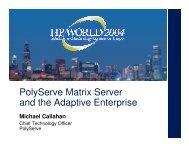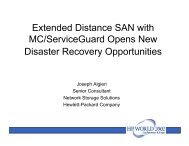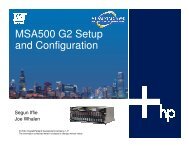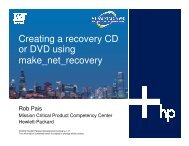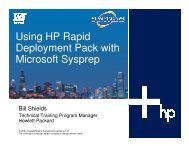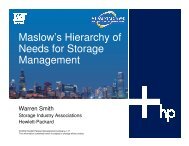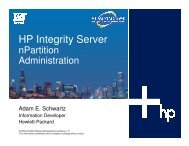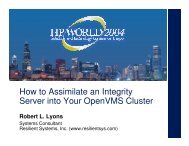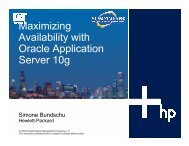TruCluster on HP-UX: How does it look? - OpenMPE
TruCluster on HP-UX: How does it look? - OpenMPE
TruCluster on HP-UX: How does it look? - OpenMPE
You also want an ePaper? Increase the reach of your titles
YUMPU automatically turns print PDFs into web optimized ePapers that Google loves.
<str<strong>on</strong>g>TruCluster</str<strong>on</strong>g> <strong>on</strong> <strong>HP</strong>-<strong>UX</strong>:<br />
<strong>How</strong> <strong>does</strong> <strong>it</strong> <strong>look</strong>?<br />
Greg Yates (gry@hp.com)<br />
C<strong>on</strong>sultant<br />
Hewlett-Packard<br />
© 2004 Hewlett-Packard Development Company, L.P.<br />
The informati<strong>on</strong> c<strong>on</strong>tained herein is subject to change w<strong>it</strong>hout notice
Disclaimer<br />
The informati<strong>on</strong> in this presentati<strong>on</strong> is for a product<br />
that is still in development. C<strong>on</strong>sequently the<br />
plans presented here are subject to change.<br />
2
Introducti<strong>on</strong><br />
• This presentati<strong>on</strong> will focus <strong>on</strong> the IPF (Itanium)<br />
platform<br />
• <str<strong>on</strong>g>TruCluster</str<strong>on</strong>g> CFS (Cluster File System)<br />
• <str<strong>on</strong>g>TruCluster</str<strong>on</strong>g> SSI (Single System Image)<br />
• AdvFS File System<br />
3
<str<strong>on</strong>g>TruCluster</str<strong>on</strong>g> <strong>on</strong> <strong>HP</strong>-<strong>UX</strong><br />
• Since we are integrating <str<strong>on</strong>g>TruCluster</str<strong>on</strong>g> into <strong>HP</strong>-<strong>UX</strong>,<br />
some of the ‘feel’ of <str<strong>on</strong>g>TruCluster</str<strong>on</strong>g>/Tru64 will be<br />
different. The idea was to integrate the product<br />
into <strong>HP</strong>-<strong>UX</strong> as seamlessly as possible.<br />
4
TCR CFS and TCR SSI<br />
• There are two distinct offerings of <str<strong>on</strong>g>TruCluster</str<strong>on</strong>g> <strong>on</strong><br />
<strong>HP</strong>-<strong>UX</strong><br />
− TCR CFS -- CFS but no shared root. The CFS-served<br />
cluster file system is /etc/cfs plus a user-available<br />
mount point called /cfs. This will ship earlier than the<br />
SSI product, in the 11.31 time-frame.<br />
− TCR SSI -- Trad<strong>it</strong>i<strong>on</strong>al <str<strong>on</strong>g>TruCluster</str<strong>on</strong>g> SSI. Complete<br />
shared cluster file systems (shared root) and user file<br />
systems.<br />
5
<str<strong>on</strong>g>TruCluster</str<strong>on</strong>g> CFS<br />
• Provided in the 11.31 release time-frame<br />
• CFS for user data file systems (no shared root)<br />
− User data in /cfs<br />
− Some cluster-wide system and TCR data in /etc/cfs<br />
• Greatly enhances Serviceguard package<br />
manager, since data file systems can be<br />
accessible from all members<br />
• Private file systems and volume managers<br />
• LAN Cluster Interc<strong>on</strong>nect<br />
• Clusterwide UIDs and GIDs (opti<strong>on</strong>)<br />
• Clusterwide PIDs (Legacy and Large PIDs)<br />
6
<str<strong>on</strong>g>TruCluster</str<strong>on</strong>g> CFS<br />
• Serviceguard Package Manager for Applicati<strong>on</strong><br />
Availabil<strong>it</strong>y<br />
− Supports applicati<strong>on</strong>s using private file systems, and<br />
volume managers as well as CFS<br />
• HA shared storage<br />
• Each member installed and maintained<br />
separately (including Applicati<strong>on</strong>s)<br />
7
<str<strong>on</strong>g>TruCluster</str<strong>on</strong>g> CFS<br />
• User data file systems (AdvFS) can be mounted<br />
cluster-wide under /cfs<br />
• DRD can be c<strong>on</strong>figured to be cluster-wide for<br />
storage devices<br />
• Cluster-wide device namespace (for CFS<br />
devices)<br />
• In<strong>it</strong>ially 4 node max (16 CPUs or less); 2 nodes if<br />
more than 16 CPUs and in<strong>it</strong>ially <strong>on</strong>ly supporting<br />
IPF<br />
8
<str<strong>on</strong>g>TruCluster</str<strong>on</strong>g> CFS<br />
Member 1<br />
/mnt /usr /var /etc<br />
projA<br />
/<br />
cfs<br />
/cfs<br />
projD<br />
Shared file systems,<br />
volumes, cfs<br />
provides automatic<br />
failover &<br />
c<strong>on</strong>current RW<br />
storage<br />
/cfs<br />
projD<br />
Member 2<br />
/<br />
/etc /var /usr<br />
cfs<br />
/mnt<br />
projB<br />
AdvFS<br />
AdvFS<br />
CLVM AdvFS<br />
projC<br />
AdvFS<br />
CLVM<br />
projC<br />
AdvFS<br />
AdvFS<br />
VxVM<br />
VxFS<br />
LVM<br />
VxFS<br />
LVM<br />
VxFS<br />
LVM<br />
AdvFS<br />
LVM<br />
HFS<br />
LVM<br />
Private file systems, volumes,<br />
storage<br />
private file systems,<br />
volumes, storage<br />
Applicati<strong>on</strong> and associated server <strong>on</strong>ly file system<br />
projC c<strong>on</strong>figured w<strong>it</strong>h VxFS and LVM stack, failover<br />
from member 1 to member 2 using SGPM scripting<br />
9
<str<strong>on</strong>g>TruCluster</str<strong>on</strong>g> SSI<br />
• Follow-<strong>on</strong> after in<strong>it</strong>ial 11.31 release although<br />
there will be some SSI enablers in 11.31<br />
• Shared root opti<strong>on</strong> (selectable: choose CFS or<br />
SSI during clu_create)<br />
• SSI Management<br />
− Management of down nodes<br />
− Single applicati<strong>on</strong> installati<strong>on</strong> and management<br />
• Install Once (since shared root)<br />
10
<str<strong>on</strong>g>TruCluster</str<strong>on</strong>g> SSI<br />
• Clusterized LVM<br />
• Clusterized NFS<br />
• Cluster Alias<br />
• Parallel Remote Executi<strong>on</strong><br />
• VPAR (virtual part<strong>it</strong>i<strong>on</strong>) as a cluster member<br />
11
<str<strong>on</strong>g>TruCluster</str<strong>on</strong>g> SSI<br />
Member 1<br />
/mnt /usr /var /etc<br />
projA<br />
AdvFS<br />
projB<br />
CLVM<br />
/<br />
cfs<br />
AdvFS<br />
/cfs<br />
projD<br />
AdvFS<br />
AdvFS CLVM<br />
projC<br />
VxFS<br />
CLVM<br />
Shared file systems,<br />
volumes, cfs<br />
provides automatic<br />
failover &<br />
c<strong>on</strong>current RW<br />
storage<br />
projC<br />
VxFS<br />
CLVM<br />
Member 2<br />
/cfs /etc /var /usr<br />
projD<br />
AdvFS<br />
CLVM<br />
cfs<br />
/<br />
/mnt<br />
projA<br />
projB<br />
AdvFS<br />
CLVM AdvFS<br />
Applicati<strong>on</strong> and associated server <strong>on</strong>ly file system<br />
projC c<strong>on</strong>figured w<strong>it</strong>h VxFS and LVM stack, failover<br />
from member 1 to member 2 using SGPM scripting<br />
12
<str<strong>on</strong>g>TruCluster</str<strong>on</strong>g> Roadmap<br />
• 2005 -- 11.31 and TCR CFS<br />
• 2006 -- Add TCR SSI as a choice point (also<br />
Cluster Alias, Clusterized NFS, etc.)<br />
13
<str<strong>on</strong>g>TruCluster</str<strong>on</strong>g> – The Big Picture<br />
• TCR CFS and TCR SSI (distinct c<strong>on</strong>figurati<strong>on</strong> opti<strong>on</strong>s)<br />
• Multi-node (4 member) <str<strong>on</strong>g>TruCluster</str<strong>on</strong>g> C<strong>on</strong>figurati<strong>on</strong><br />
• Shared Root CFS w<strong>it</strong>h AdvFS<br />
• Distributed Lock Manager<br />
• Kernel Group Services<br />
• Membership Manager (AKA C<strong>on</strong>necti<strong>on</strong> Manager)<br />
• LAN as Cluster Interc<strong>on</strong>nect<br />
• Device Request Dispatcher<br />
• Cluster Alias<br />
14
<str<strong>on</strong>g>TruCluster</str<strong>on</strong>g> – The Big Picture<br />
• Cluster-wide events (EVM)<br />
• ICSNET network driver<br />
• Cluster APIs<br />
• Symmetrical storage device c<strong>on</strong>figurati<strong>on</strong> based<br />
up<strong>on</strong> 11.31 IO stack<br />
• clu_create, clu_add_member,<br />
clu_delete_member<br />
• Cluster File System (CFS) failover<br />
• Applicati<strong>on</strong> failover<br />
• Cluster Network Adapter Failover<br />
15
Cluster File System<br />
• Same view from each member<br />
• Client/Server (in most cases)<br />
− Each file system or AdvFS domain is served by <strong>on</strong>e<br />
cluster member<br />
− A member can be a client for some domains and a<br />
server for others<br />
− A member can trans<strong>it</strong>i<strong>on</strong> between roles transparently<br />
− Server coordinates caches, meta-data updates<br />
• Client reads directly from storage, wr<strong>it</strong>es through server<br />
• Full X/OPEN, POSIX file system semantics w<strong>it</strong>h<br />
binary compatibil<strong>it</strong>y<br />
16
Cluster File System<br />
• Cluster-wide cache coherency<br />
• Transparent file system failover and recovery<br />
• Integrated w<strong>it</strong>h Cluster Alias for NFS server<br />
17
Member-specific files<br />
• So, how do I keep member-specific c<strong>on</strong>figurati<strong>on</strong><br />
info separate?<br />
• CDSLs – C<strong>on</strong>text Dependent Symbolic Link<br />
• For example the /stand directory:<br />
lrwxr-xr-x 1 root sys 26 Jun 30 19:22<br />
/stand -> ./.cdsl_files/{memb}/stand<br />
• {memb} represents the member number and is<br />
translated real-time<br />
• Create your own CDSLs w<strong>it</strong>h mkcdsl(1M)<br />
18
Cluster Management<br />
• clu_create/clu_add_member/clu_delete_member<br />
– These work largely as before (Tru64) -- see<br />
later slide<br />
• cluamgr – Set up and c<strong>on</strong>figure the cluster alias<br />
• clu_get_info – Display cluster informati<strong>on</strong> (such<br />
as member number, status, etc.<br />
• clu_type – Display cluster type (CFS or SSI)<br />
19
Cluster Management<br />
• cmrunpkg, cmmodpkg -- Serviceguard package<br />
manager commands c<strong>on</strong>trol package placement.<br />
(Very much like CAA.)<br />
• kctune – similar to sysc<strong>on</strong>fig, display/modify<br />
cluster subsystem attributes<br />
• EVM – The event management su<strong>it</strong>e of<br />
commands is much the same as <strong>on</strong> Tru64<br />
20
clu_* util<strong>it</strong>ies differences<br />
• The type specified to clu_create determines<br />
whether the cluster being created is CFS or SSI<br />
• There will be a complete command-line interface<br />
for all three util<strong>it</strong>ies. Both the command-line and<br />
.cfg file interfaces are completely n<strong>on</strong>interactive<br />
• clu_delete_member supports a .cfg file (<strong>it</strong> did not<br />
<strong>on</strong> Tru64)<br />
• A command-line opti<strong>on</strong> allows you to check the<br />
correctness of the c<strong>on</strong>fig parameters w<strong>it</strong>hout<br />
actually performing the clu_* acti<strong>on</strong><br />
21
Device Naming<br />
• For now, device naming follows the trad<strong>it</strong>i<strong>on</strong>al<br />
<strong>HP</strong>-<strong>UX</strong> style of /dev/[r]dsk/cXtYdZ.<br />
• The delivered product will have generic device<br />
naming such as /dev/[r]disk/diskN.<br />
22
Cluster Alias<br />
• View Cluster as a single system<br />
• Can set up multiple aliases<br />
• Transparent node/adapter failover<br />
• Changed commands<br />
− cluamgr -c opti<strong>on</strong> -- cluster; -m -- member(s); -S --<br />
traffic statistics (new);<br />
• Virtual subnets for alias no l<strong>on</strong>ger supported<br />
(very rarely used)<br />
− -r changed<br />
23
Managing applicati<strong>on</strong>s --<br />
Serviceguard<br />
• If an applicati<strong>on</strong> works <strong>on</strong> a single <strong>HP</strong>-<strong>UX</strong><br />
system, <strong>it</strong> will work (<strong>on</strong> at least <strong>on</strong>e node at a<br />
time) in a Cluster as a single-instance applicati<strong>on</strong><br />
• Familiar Serviceguard<br />
• Base services such as Sendmail and Printing<br />
24
System Management Interface<br />
• Web-based client for multi-cluster<br />
• “SAM” for single node/single cluster<br />
• Goal is (no surprise) that system management in<br />
a Single System Image (SSI) cluster c<strong>on</strong>tinues to<br />
<strong>look</strong> like a single system. No need to add users<br />
<strong>on</strong> all members, mount file systems <strong>on</strong> each<br />
member, install software <strong>on</strong> each member, etc.<br />
25
Product Features by C<strong>on</strong>figurati<strong>on</strong><br />
Feature<br />
Cluster-wide file systems<br />
Cluster-wide device<br />
names<br />
Cluster-wide device<br />
access<br />
Cluster alias<br />
Applicati<strong>on</strong> failover w<strong>it</strong>h<br />
SGPM<br />
TCR CFS<br />
Customer selects which userdata<br />
file systems use CFS.<br />
AdvFS is required for file<br />
systems under CFS use. Small<br />
set of system files also use<br />
CFS.<br />
All storage devices have<br />
cluster-wide locati<strong>on</strong><br />
independent device names<br />
Administrator selects subset<br />
of storage for cluster-wide<br />
access<br />
One alias by default.<br />
Customers can c<strong>on</strong>figure<br />
multiple aliases.<br />
Serviceguard packages can<br />
failover between members and<br />
can be c<strong>on</strong>figured to use any<br />
<strong>HP</strong>-<strong>UX</strong> supported file<br />
system/volume manager pair.<br />
TCR SSI<br />
All file systems, including<br />
the root, are CFS. AdvFS<br />
file systems are highly<br />
available w<strong>it</strong>h CFS.<br />
Same<br />
All storage devices have<br />
cluster-wide access<br />
Same<br />
Serviceguard packages can<br />
failover between members<br />
and can be c<strong>on</strong>figured to<br />
use any file system and<br />
CLVM.<br />
26
Management Capabil<strong>it</strong>ies by<br />
C<strong>on</strong>figurati<strong>on</strong><br />
Feature<br />
System management<br />
Management of down<br />
members<br />
Installati<strong>on</strong> of software<br />
TCR CFS<br />
OS management must be<br />
performed per member.<br />
Management operati<strong>on</strong>s must<br />
be applied to down member<br />
when they next boot.<br />
Software must be installed <strong>on</strong><br />
each member.<br />
TCR SSI<br />
OS management is<br />
generally applied to all<br />
cluster members.<br />
Since most management<br />
operati<strong>on</strong>s apply to the<br />
cluster, down members<br />
inher<strong>it</strong> the changes<br />
automatically when they<br />
boot.<br />
Software is installed <strong>on</strong>ce<br />
for the entire cluster.<br />
27
Hardware/Software c<strong>on</strong>figurati<strong>on</strong>s<br />
Feature TCR CFS<br />
TCR SSI<br />
Platforms<br />
IA for 11.31 time-frame.<br />
IA after 11.31<br />
Volume managers<br />
Support for VxVM and LVM for n<strong>on</strong>-<br />
CFS file systems in 11.31. LVM<br />
support for CFS as a follow-<strong>on</strong>.<br />
Clusterized LVM supported.<br />
File Systems<br />
Storage Opti<strong>on</strong>s<br />
Interc<strong>on</strong>nects<br />
All <strong>HP</strong>-<strong>UX</strong> supported file systems are<br />
available for private access. AdvFS<br />
can be mounted for cluster-wide<br />
access.<br />
FC for physically shared storage.<br />
Any <strong>HP</strong>-<strong>UX</strong> supported storage<br />
privately attached.<br />
LAN (Gb) w<strong>it</strong>h IB to follow.<br />
IB will be supported for RAC<br />
messaging.<br />
All <strong>HP</strong>-<strong>UX</strong> supported file<br />
systems are available as<br />
server_<strong>on</strong>ly (access by <strong>on</strong>ly<br />
<strong>on</strong>e member at a time).<br />
AdvFS file systems are cluster<br />
wide.<br />
Same<br />
Same<br />
Node count<br />
4 nodes in 11.31.<br />
Same<br />
28
AdvFS
AdvFS – The Big Picture<br />
• Logging and Transacti<strong>on</strong>s<br />
• POSIX functi<strong>on</strong>al<strong>it</strong>y<br />
• AdvFS tools integrated into <strong>HP</strong>-<strong>UX</strong> toolset<br />
• Support for <strong>HP</strong>-<strong>UX</strong> root and boot file sytems (/,<br />
/stand, /etc, …)<br />
• Direct I/O<br />
• B+ tree directory indices<br />
• Integrati<strong>on</strong> w<strong>it</strong>h <strong>HP</strong>-<strong>UX</strong> patented Read Ahead<br />
Soluti<strong>on</strong><br />
30
AdvFS – The Big Picture<br />
• Multiple Volume File System Management –<br />
including dynamic volume add and remove<br />
• Online file system expansi<strong>on</strong> (extendfs, fsadm) as<br />
a result of underlying volume/LUN expansi<strong>on</strong><br />
• File Defragmentati<strong>on</strong> and Migrati<strong>on</strong><br />
• VFAST Automated Policy Engine<br />
• Freeze/Thaw in support of array snapshots and<br />
snapcl<strong>on</strong>es<br />
31
AdvFS – The Big Picture<br />
• Performance<br />
− Online defragmentati<strong>on</strong><br />
− Rebalancing<br />
− Self-tuning (hot file, balancing, defragmenting, etc.)<br />
− B+ tree index<br />
− DirectIO<br />
• Sizes (16TB single file; 512TB file system)<br />
• Serviceabil<strong>it</strong>y (m<strong>on</strong><strong>it</strong>oring, fine grain fault<br />
isolati<strong>on</strong>, <strong>on</strong>-line verificati<strong>on</strong>)<br />
32
AdvFS – Some differences<br />
• No c<strong>on</strong>cept of a fileset <strong>on</strong> <strong>HP</strong>-<strong>UX</strong><br />
(corresp<strong>on</strong>dingly, the fileset-related<br />
commands/sw<strong>it</strong>ches are g<strong>on</strong>e)<br />
− This means no multi-fileset domains<br />
• No frag file<br />
• No file striping<br />
33
AdvFS – Some differences<br />
• Unified Buffer Cache (UBC) is replaced w<strong>it</strong>h<br />
Unified File Cache (UFC)<br />
• No cl<strong>on</strong>efset, use hardware cl<strong>on</strong>ing/snapshots<br />
instead<br />
• /etc/fdmns is replaced w<strong>it</strong>h /dev/advfs<br />
• /dev/advfs<br />
− default (block device)<br />
− Link to storage is actually in the .stg subdirectory<br />
34
AdvFS command (changes from<br />
Tru64)<br />
• addvol<br />
• rmvol<br />
• advscan<br />
• chfsets<br />
• chvol<br />
• defragment<br />
• migrate<br />
• mount -o extend<br />
fsadm addvol<br />
fsadm rmvol<br />
fsadm scan<br />
fsadm chfs<br />
fsadm chio<br />
fsadm defrag<br />
fsadm migrate<br />
fsadm extend<br />
35
AdvFS command (changes from<br />
Tru64)<br />
• savemeta<br />
• showfdmn<br />
• showfile<br />
• sw<strong>it</strong>chlog<br />
• vfast<br />
fsadm savemeta<br />
fsadm (-F advfs)<br />
fsadm getattr<br />
fsadm mvlog<br />
fsadm autotune<br />
36
AdvFS command (changes from<br />
Tru64)<br />
• advfsstat<br />
advstat<br />
• diskusg<br />
advdiskusg<br />
• salvage<br />
advsalvage<br />
• mktrashcan advtrashcan -m<br />
• rmtrashcan advtrashcan -r<br />
• shtrashcan advtrashcan<br />
• nvbmtpg,nvlogpg<br />
nvtagpg,vfilepg<br />
vsbmpg<br />
advvods (various sw<strong>it</strong>ches)<br />
37
AdvFS command (changes from<br />
Tru64)<br />
• rvdump<br />
• rverstore<br />
• vdump<br />
• vrestore<br />
advrdump<br />
advrrestore<br />
advdump<br />
advrestore<br />
38
AdvFS command (changes from<br />
Tru64)<br />
• fixfdmn<br />
• verify<br />
• mkfdmn<br />
• rmfdmn<br />
• mountlist<br />
• tag2name<br />
fsck<br />
fsck<br />
mkfs/newfs<br />
fsadm rmfs<br />
mount<br />
ncheck<br />
39
AdvFS/Cluster Demo<br />
• AdvFS multi-volume functi<strong>on</strong>al<strong>it</strong>y<br />
• Cluster-wide mount<br />
• Add a user<br />
• Install software (Apache – multi-instance)<br />
• Cluster Alias (distributi<strong>on</strong> of c<strong>on</strong>necti<strong>on</strong>s)<br />
• Oracle (single-instance)<br />
40
Resources<br />
• Sessi<strong>on</strong> 3849 -- 08/16/200405:15PM “Nuts and<br />
Bolts of Enhanced Secur<strong>it</strong>y Management for<br />
Tru64 UNIX”<br />
• Sessi<strong>on</strong> 3847 -- 08/18/2004 at 11:00AM “Best<br />
Practices for Patching and Upgrading Tru64<br />
UNIX and <str<strong>on</strong>g>TruCluster</str<strong>on</strong>g>s<br />
• Sessi<strong>on</strong> 3761 -- 08/19/2004 at 01:30PM “A Sideby-Side<br />
Comparis<strong>on</strong> of Tru64 UNIX and <strong>HP</strong>-<strong>UX</strong><br />
11i v2 Hardware Management”<br />
• Sessi<strong>on</strong> 3878 -- 08/20/2004 11:00AM “Tru64<br />
UNIX v5.1x <str<strong>on</strong>g>TruCluster</str<strong>on</strong>g> Recovery Techniques”<br />
• http://hp.com/go/hp-ux<br />
41
Hear more about our service offerings by<br />
vis<strong>it</strong>ing us in the Soluti<strong>on</strong>s Showcase!<br />
• <strong>HP</strong> Web Support Tools<br />
• <strong>HP</strong> Active Savings Tool<br />
• <strong>HP</strong> Educati<strong>on</strong><br />
• <strong>HP</strong> Business C<strong>on</strong>tinu<strong>it</strong>y & Availabil<strong>it</strong>y Soluti<strong>on</strong>s<br />
• <strong>HP</strong> Adaptive Enterprise Agil<strong>it</strong>y Assessment<br />
• <strong>HP</strong> Financial Services<br />
• <strong>HP</strong> IT C<strong>on</strong>solidati<strong>on</strong> Soluti<strong>on</strong>s<br />
• <strong>HP</strong> Radio Frequency Identificati<strong>on</strong> (RFID)<br />
42
Co-produced by:
Extra slides
General <strong>HP</strong>-<strong>UX</strong> Informati<strong>on</strong>gathering<br />
util<strong>it</strong>ies<br />
• machinfo (IA-<strong>on</strong>ly) – display informati<strong>on</strong> about<br />
CPUs, firmware, memory, etc.<br />
• tddiag – display t<strong>on</strong>s of c<strong>on</strong>figurati<strong>on</strong> data… t<strong>on</strong>s<br />
(this util<strong>it</strong>y ships w<strong>it</strong>h the Tachy<strong>on</strong> FC card)<br />
• fcmsutil (/dev/td0) – get detailed informati<strong>on</strong><br />
about your fiber channel<br />
• kctune | grep -E<br />
"advfs|cfs|clua|cnx|ics|kgs|drd|clubase" – display<br />
settings of various cluster (and file system)<br />
settings<br />
45
Devices -- Troubleshooting<br />
• cfgv,cfgc,cfgs -- display/modify the devices <strong>on</strong> a system<br />
(to see the disk devices cfgv -r comp<strong>on</strong>ent -c disk).<br />
Similar to hwmgr <strong>on</strong> Tru64.<br />
• dfsv,dfsc,dfss -- display/modify device names. Similar to<br />
dsfmgr in Tru64.<br />
• lssf -- get bus, target, LUN, path info for a particular<br />
device (lssf /dev/dsk/c4t0d3). Similar to the file command<br />
in Tru64.<br />
• diskinfo -- provide some useful informati<strong>on</strong> about the disk,<br />
like the size (diskinfo /dev/rdsk/c10t0d6)<br />
• fstype -- display the file system type (fstyp<br />
/dev/rdsk/c10t0d6s2)<br />
46
Devices -- Troubleshooting<br />
• devnm -- find out what storage is associated w<strong>it</strong>h<br />
a particular file system (devnm . Or devnm /var).<br />
If the underlying file system is AdvFS, you’ll get<br />
the domain name (not the actual devices).<br />
47





